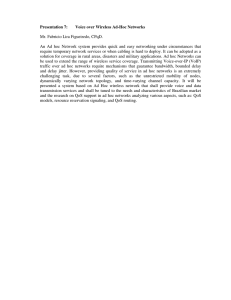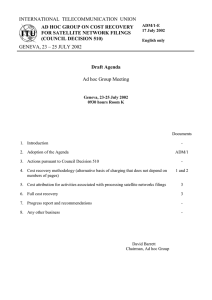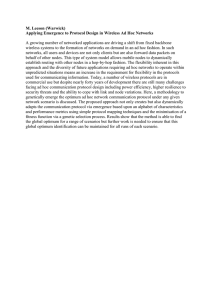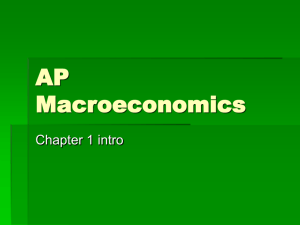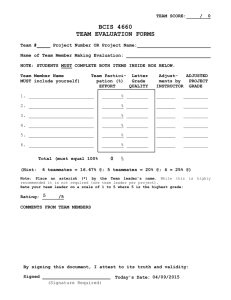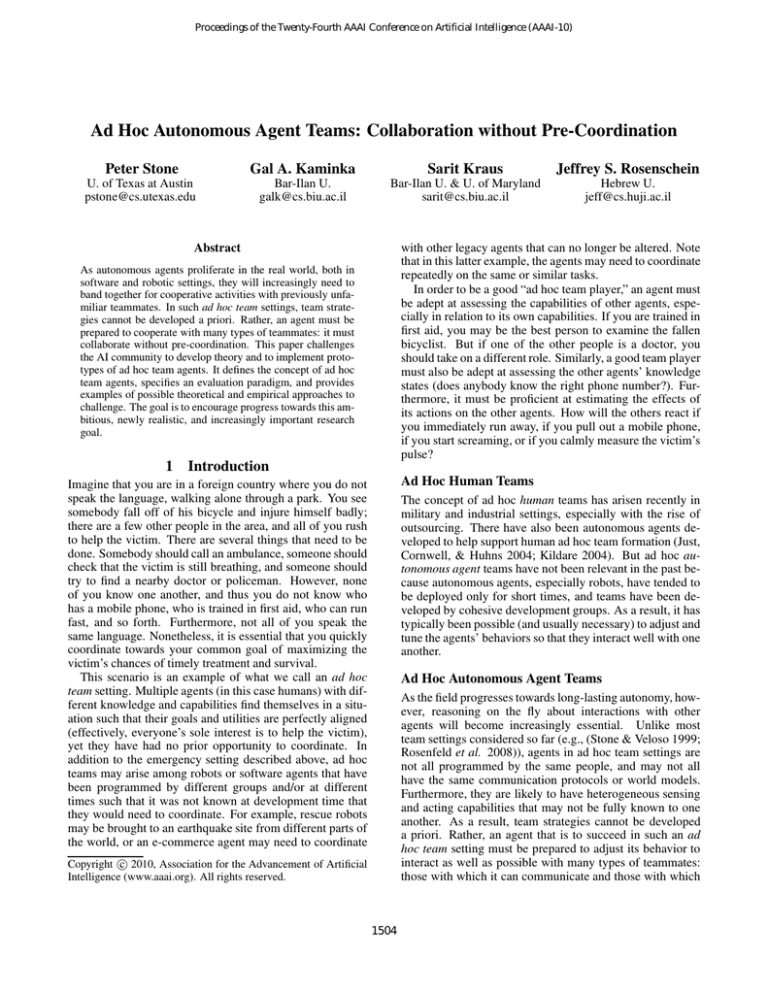
Proceedings of the Twenty-Fourth AAAI Conference on Artificial Intelligence (AAAI-10)
Ad Hoc Autonomous Agent Teams: Collaboration without Pre-Coordination
Peter Stone
Gal A. Kaminka
Sarit Kraus
Jeffrey S. Rosenschein
U. of Texas at Austin
pstone@cs.utexas.edu
Bar-Ilan U.
galk@cs.biu.ac.il
Bar-Ilan U. & U. of Maryland
sarit@cs.biu.ac.il
Hebrew U.
jeff@cs.huji.ac.il
Abstract
with other legacy agents that can no longer be altered. Note
that in this latter example, the agents may need to coordinate
repeatedly on the same or similar tasks.
In order to be a good “ad hoc team player,” an agent must
be adept at assessing the capabilities of other agents, especially in relation to its own capabilities. If you are trained in
first aid, you may be the best person to examine the fallen
bicyclist. But if one of the other people is a doctor, you
should take on a different role. Similarly, a good team player
must also be adept at assessing the other agents’ knowledge
states (does anybody know the right phone number?). Furthermore, it must be proficient at estimating the effects of
its actions on the other agents. How will the others react if
you immediately run away, if you pull out a mobile phone,
if you start screaming, or if you calmly measure the victim’s
pulse?
As autonomous agents proliferate in the real world, both in
software and robotic settings, they will increasingly need to
band together for cooperative activities with previously unfamiliar teammates. In such ad hoc team settings, team strategies cannot be developed a priori. Rather, an agent must be
prepared to cooperate with many types of teammates: it must
collaborate without pre-coordination. This paper challenges
the AI community to develop theory and to implement prototypes of ad hoc team agents. It defines the concept of ad hoc
team agents, specifies an evaluation paradigm, and provides
examples of possible theoretical and empirical approaches to
challenge. The goal is to encourage progress towards this ambitious, newly realistic, and increasingly important research
goal.
1 Introduction
Ad Hoc Human Teams
Imagine that you are in a foreign country where you do not
speak the language, walking alone through a park. You see
somebody fall off of his bicycle and injure himself badly;
there are a few other people in the area, and all of you rush
to help the victim. There are several things that need to be
done. Somebody should call an ambulance, someone should
check that the victim is still breathing, and someone should
try to find a nearby doctor or policeman. However, none
of you know one another, and thus you do not know who
has a mobile phone, who is trained in first aid, who can run
fast, and so forth. Furthermore, not all of you speak the
same language. Nonetheless, it is essential that you quickly
coordinate towards your common goal of maximizing the
victim’s chances of timely treatment and survival.
This scenario is an example of what we call an ad hoc
team setting. Multiple agents (in this case humans) with different knowledge and capabilities find themselves in a situation such that their goals and utilities are perfectly aligned
(effectively, everyone’s sole interest is to help the victim),
yet they have had no prior opportunity to coordinate. In
addition to the emergency setting described above, ad hoc
teams may arise among robots or software agents that have
been programmed by different groups and/or at different
times such that it was not known at development time that
they would need to coordinate. For example, rescue robots
may be brought to an earthquake site from different parts of
the world, or an e-commerce agent may need to coordinate
The concept of ad hoc human teams has arisen recently in
military and industrial settings, especially with the rise of
outsourcing. There have also been autonomous agents developed to help support human ad hoc team formation (Just,
Cornwell, & Huhns 2004; Kildare 2004). But ad hoc autonomous agent teams have not been relevant in the past because autonomous agents, especially robots, have tended to
be deployed only for short times, and teams have been developed by cohesive development groups. As a result, it has
typically been possible (and usually necessary) to adjust and
tune the agents’ behaviors so that they interact well with one
another.
Ad Hoc Autonomous Agent Teams
As the field progresses towards long-lasting autonomy, however, reasoning on the fly about interactions with other
agents will become increasingly essential. Unlike most
team settings considered so far (e.g., (Stone & Veloso 1999;
Rosenfeld et al. 2008)), agents in ad hoc team settings are
not all programmed by the same people, and may not all
have the same communication protocols or world models.
Furthermore, they are likely to have heterogeneous sensing
and acting capabilities that may not be fully known to one
another. As a result, team strategies cannot be developed
a priori. Rather, an agent that is to succeed in such an ad
hoc team setting must be prepared to adjust its behavior to
interact as well as possible with many types of teammates:
those with which it can communicate and those with which
c 2010, Association for the Advancement of Artificial
Copyright Intelligence (www.aaai.org). All rights reserved.
1504
if there is some subset B ⊂ A such that a ∈ B, and the
team comprised of the agents in B is able to achieve a minimal threshold expected performance, smin , on all tasks in
D:1
it cannot; those that are more mobile and those that are less
mobile; those with better sensing capabilities and those with
worse capabilities. A good team player’s best actions are
likely to differ significantly depending on the characteristics
of its teammates. The fact that humans are routinely called
upon to coordinate in an ad hoc fashion strongly motivates
the challenge of constructing autonomous agents of similar
flexibility.
∀a ∈ A, ∀d ∈ D, ∃B ⊂ A s.t. a ∈ B ∧ E[s(B, d)] ≥ smin
Note that it may be possible for an individual agent to
achieve smin , for instance in a domain such as foraging
where having teammates is helpful but not essential; or D
may be a fundamentally multiagent domain in which agent
teams are needed to perform the task at all, such as pushing heavy boxes. Note further that the agents in A need not
be themselves aware that they are acting as teammates; indeed when they are “team aware” the interactions among the
agents can become considerably more complex.
We propose comparing agents a0 and a1 as potential ad
hoc teammates of the agents in set A in domain D according
to the following procedure.
The Challenge
Our challenge to the community identifies a specific, novel,
high-risk, but high-payoff research area. Specifically, we
call for theoretical treatments and concrete implementations
of robust, autonomous agents that are good ad hoc team
players.
That is, we challenge the community:
To create an autonomous agent that is able to efficiently and robustly collaborate with previously
unknown teammates on tasks to which they are all
individually capable of contributing as team members.
Evaluate(a0, a1 , A, D)
• Initialize performance (reward) counters r0 and r1 for
agents a0 and a1 respectively to r0 = r1 = 0.
• Repeat:
– Sample a task d from D.
– Randomly draw a subset of agents B, |B| ≥ 2, from A
such that E[s(B, d)] ≥ smin .
– Randomly select one agent b ∈ B to remove from the
team to create the team B − .
– increment r0 by s({a0 } ∪ B − , d)
– increment r1 by s({a1 } ∪ B − , d)
• If r0 > r1 then we conclude that a0 is a better ad-hoc
team player than a1 in domain D over the set of possible
teammates A.
The remainder of this paper is organized as follows. First,
Section 2 gives further insight into the details of the challenge via a specification of how potential solutions can be
evaluated. Then, Sections 3 and 4 discuss possible theoretical and empirical approaches to the challenge, respectively.
Section 5 expands on the ways in which the challenge can be
decomposed and/or the scope of the challenge can be gradually increased, Section 6 touches on prior research most
related to the challenge, and Section 7 concludes.
2 Evaluation
Though there is plenty of room for theoretical treatment of
the problem (see Section 3), the challenge introduced in Section 1 is ultimately an empirical challenge. Additionally,
though it pertains to teamwork, it is fundamentally a challenge pertaining to building a single autonomous agent. In
this section, we shed further light on the intention of the
challenge by specifying a way in which potential solutions
can be evaluated.
Let a0 and a1 be two ad hoc teammates whose performance is to be compared in domain D, from which tasks d
can be sampled. For example, D may be a multiagent planning domain with each task having different initial conditions and/or goals; or D may be robot soccer, with each task
being a match against a particular opponent team. It may
also be the case that there is only one task in the domain that
is repeatedly “sampled.”
Assume that there is some quantitative performance measure, or “score” s(B, d), that results when a set of agents
B performs task d once, such as time to goal achievement,
joint discounted reward over a fixed time, number of goals
scored, or any other objective measure. Note that s may be
a stochastic function.
Let there be a pool of potential teammates A =
{a2 , . . . , an }, each of which has some competency in domain D. Specifically, we say that agent a ∈ A is competent
Note that there is a lot of potential variability both in the
breadth of the domain D (how different the tasks can be) and
especially in the breadth of teammate capabilities in A. We
address these issues in more detail in Section 5. Note that we
assume that agents a0 and a1 are aware of the domain D and
the set of potential teammates A. But A may have infinite
cardinality, in effect just placing bounds on teammate characteristics, such as the teammate will not be able to move
faster than 2 m/s. In addition, even if A is finite, on each
iteration the set B − is initially unknown to the ad hoc team
agents being evaluated.
This evaluation paradigm serves to emphasize that an ad
hoc team agent is fundamentally an individual agent. To be
successful, it must perform well with any set of teammates
with which it is presented.
3 Example Theoretical Approach
Although our challenge is ultimately empirical, there is also
ample room for theoretical analysis of components of the
full problem. For example, aspects of ad hoc teamwork
1
For notational convenience, we assume that larger performance values indicate better task performance.
1505
• The learner’s behavior is fixed and known: it acts greedily, always selecting the arm with the highest observed
sample average so far. If there are any previously unseen
arms, the learner selects one of them randomly (optimistic
initialization).
can be usefully studied within the framework of game theory (Leyton-Brown & Shoham 2008). Specifically, a good
ad hoc team agent should be able to learn to interact with a
previously unknown teammate in a fully cooperative (common payoff) iterative normal form game. If the teammate
plays a fixed (possibly stochastic) strategy, the ad hoc team
agent should simply learn what that strategy is and play the
best response. But even in this simplest of scenarios, the
problem can become quite intricate to analyze if the teammate may itself be adaptive.
The teacher must then decide whether to do what is best in
the short term, namely pull the arm with the highest expected
payoff; or whether to increase the information available to
its teammate, the learner, by pulling a different arm. Note
that if the teacher were acting alone, trivially its optimal action would be to always pull the arm with highest expected
payoff.
By these assumptions, the learner is both less capable and
less knowledgeable than the teacher, and it does not understand direct communication from the teacher. It is tempting
to think that we should begin by improving the learner. But
in the ad hoc team setting, that is not an option. The learner
“is what it is” either because it is a legacy agent, or because
it has been programmed by others. Our task is to determine
the teacher’s best actions given such learner behavior.
This setting is only a limited representation of the full
ad hoc team setting from Section 1. However it retains
the most essential property, namely that a single agent in
our control must interact with a teammate without the advance coordination. Nonetheless, even this initial scenario
presents some interesting mathematical challenges. Specifically, Stone and Kraus prove several theoretical results pertaining to which arms the teacher should consider pulling,
and under what conditions (including for the natural generalization with more than three arms). Furthermore, when
the payoffs from the arms are discrete, they present a polynomial algorithm for the teacher to find the optimal arm to
pull. (Stone & Kraus 2010).
The study of collaborative k-armed bandits described in
this section serves as a starting point for the theoretical analysis of ad hoc teams. However it leaves open many directions for extensions: situations in which the teacher does not
have full knowledge, the learner is “team aware,” the number of iterations is not known, and/or the learner’s behavior
is not known a priori to the teacher, among others. We hope
that this ad hoc teamwork challenge will inspire many new
and challenging problems in the theoretical analysis of optimal control and optimal teamwork.
Collaborative Multi-Armed Bandits
As an initial theoretical analysis of an aspect of ad hoc teamwork, Stone and Kraus (2010) consider a situation in which
the ad hoc team player interacts repeatedly in a stochastic
environment with a teammate that is both less capable and
less knowledgeable than itself. Specifically, the teammate
can only execute a subset of the actions that the ad hoc team
agent can execute, and, unlike the ad hoc team agent, it is unaware of the relative utilities of the various actions. It is also
unaware that it is acting as a part of a team. They formalize this situation as an instance of the well-studied k-armed
bandit problem (Robbins 1952).
The basic setting of the k-armed bandit problem is as follows. At each time step, a learning agent selects one of the k
arms to pull. The arm returns a payoff according to a fixed,
but generally unknown, distribution. The agent’s goal is to
maximize the sum of the payoffs it receives over time. The
setting is well-suited for studying exploration vs. exploitation: at any given time, the agent could greedily select the
arm that has paid off the best so far, or it could select a different arm in order to gather more information about its distribution. Though k-armed bandits are often used for this
purpose, the authors were the first to consider a multiagent
cooperative setting in which the agents have different knowledge states and action capabilities.
In order to study the ad hoc team problem, the authors
extend the standard setting to include two distinct agents,
known as the teacher and the learner, who select arms alternately, starting with the teacher. They initially consider a
bandit with just three arms such that the teacher is able to
select from any of the three arms, while the learner is only
able to select from among the two arms with the lower expected payoffs. The authors consider the fully cooperative
case such that the teacher’s goal is to maximize the expected
sum of the payoffs received by the two agents over time (the
teacher is risk neutral). Specifically, the authors make the
following assumptions:
4
Example Empirical Approach
While theoretical analyses are likely to be able to identify
some situations in which optimal decision-making is possible, they are also likely to identify aspects of ad hoc teamwork that are not tractably solvable. There are also likely to
be aspects of ad hoc teamwork that are not easily analyzable
at all. In such aspects of the problem, there will be plenty
of room for useful empirical analyses. In this section, we
illustrate a possible empirical approach using the domain of
robot soccer.
• The payoff distributions of all arms are fully known to the
teacher, but unknown to the learner.
• The learner can only select from among the two arms with
the lower expected payoffs.
• The results of all actions are fully observable (to both
agents).
Human Soccer
• The number of rounds (actions per agent) remaining is
finite and known to the teacher.
Human soccer is a perfect example of the ad hoc team setting. When given the opportunity, teams of human soccer
1506
players train together and hone their interactions so as to refine their ability to cooperate with one another. However individual soccer players are also able to join “pick-up” games
with players that they’ve never met before, let alone played
with. They can even do so in foreign countries where they
don’t know the language, leaving no way to communicate
with their ad hoc teammates other than mutual observation
and experimentation. A talented human player is able to
make quick judgments about how she will best fit into her
ad hoc team. When playing with worse players, she is likely
to play in the center of the field; when playing with better
players she may look for a supporting role that limits responsibility. Furthermore, at the beginning of the game, it
may be useful in this situation to take actions that highlight
one’s particular strengths, such as kicking with the left foot,
or passing the ball precisely, so as to teach one’s teammates
how best to incorporate the newcomer into the team.
cess of creating a fully capable ad hoc team player is that it
is akin to equipping it with a toolbox, each tool being useful
for interacting with a class of possible teammates, as well
as with a method for identifying to which class the current
teammates belong.
From this perspective, in order to create an ad hoc team
player, one will need to address three high-level technical
challenges.
1. Identify the full range of possible teamwork situations
that a complete ad hoc team player needs to be capable
of addressing.
2. For each such situation, find theoretically optimal and/or
empirically effective algorithms for behavior.
3. Develop methods for identifying and classifying which
type of teamwork situation the agent is currently in, in
an online fashion.
Challenges 2 and 3 are the core technical aspects of the challenge. But the first can also be seen as a sort of knob, which
can be used to incrementally increase the difficulty of the
challenge.
For this purpose, we start from the literature on ad hoc
human team formation (Kildare 2004) to organize teamwork
situations along three dimensions:
Robot Soccer
Similarly, robot soccer teams at the international RoboCup
competitions are typically developed as cohesive units with
communication protocols and sophisticated methods for distributing the players on the field into complementary positions (Stone & Veloso 1999). However, it is also possible to
consider a “pick-up” game in which the players are not able
to pre-coordinate.
As an instantiation of the bandit example in Section 3,
one could consider a center midfielder, who can pass to any
of three forwards, teaching an outside midfielder, who can
only pass to two of them. If the outside midfielder is new to
the team and still learning about the forwards’ capabilities,
we find ourselves in an instantiation of exactly the abstract
k-armed bandit scenario. Just as in the abstract setting, it is
naturally extensible to model sophisticated learners, partial
teacher knowledge, unknown learner behavior, and so on.
Eventually, one can imagine staging field tests of ad hoc
team agents at the annual RoboCup competitions. Several
participants with robots of varying strengths could be invited
to participate in a robot soccer “pick-up game.” That is, the
robots would be placed on the field as a team without any
prior coordination among the human programmers.
A successful ad hoc team player will be able to quickly
evaluate whether it is playing with forwards or defenders,
whether it is playing with more skillful players or with less
skillful players, etc., and adjust its play accordingly. If it is
placed on a team with no goalie, then it should notice and
adopt that role; if it is placed on a team with worse players,
it should actively go to the ball more often, and so on.
The essential aspect is that the ad hoc team player should
be able to deal with whatever teammates it might come
across, and without any foreknowledge of the teammates’
actual behaviors on the part of the agents or the programmers.
5
Teammate characteristics: features of the individual
teammates such as action capabilities, sensing capabilities, decision making and learning capabilities, whether
they can communicate directly, and prior knowledge.
Team characteristics: features of the collection of team
members such as whether they are homogeneous or heterogeneous, how many teammates are on the team, and
whether they can observe each other’s actions.
Task characteristics: features of the cooperative task to be
performed such as the goal, the time horizon, whether it is
turn-taking, and how closely coordinated the agents need
to be in their actions. Can they divide the task at a high
level and then act independently, or do they need to coordinate low-level actions?
By initially limiting teammate, team, and task characteristics (A and D from Section 2), we can render the challenge approachable even though the full-blown version is
quite ambitious. For example, Stone and Kraus’s k-armed
bandit scenario summarized in Section 3 is appropriate for
situations in which the teammates have limited action capabilities, perfect sensing, greedy decision making, no direct communication, and prior knowledge limited to their
own observations; the team is heterogeneous, consists of two
agents, and can fully observe each other’s actions; and the
task’s goal is to maximize the sum of discrete action utilities over a finite horizon where the agents act individually
in a turn-taking fashion. In that work, the authors found the
theoretically optimal action for the ad hoc team player, thus
taking a first step towards research challenge 2.
We expect that the initial responses to this challenge will
address subproblems by similarly limiting the scopes of A
and D. Indeed, most of the examples given in this paper
consider sets A such that the potential teammates are not
Controlling the Scope: Task and
Teammate Breadth
An ad hoc team player must be prepared to collaborate with
all types of teammates. Thus one possible view of the pro-
1507
action. Thus in some sense, the teacher is not “embedded”
in the environment as a real teammate.
Although the complete challenge put forth in this paper
is very ambitious and likely to take many years to meet in
a fully satisfactory way, there are numerous existing techniques that may be useful starting points for certain aspects
of the challenge (e.g., for certain properties of A and D).
The remainder of this section provides a small sampling of
such existing techniques.
even necessarily aware that they are a part of an ad hoc team;
this case is the simplest to consider. However, it will be
an important aspect of the challenge to consider sets A that
include other agents that are aware that they are on an ad hoc
team. Eventually, there will be opportunities to generalize
and/or combine these subproblems into a more complete ad
hoc team agent.
6
Discussion and Related Work
• As mentioned in Section 3, game theory (Leyton-Brown
& Shoham 2008) provides a useful theoretical foundation
for multiagent interaction. Though originally intended as
a model for human encounters (or those of human institutions), it has become much more broadly applied over the
last several decades.
This challenge is predicated on the assumption that software
agents and robots will soon be able to be deployed for extended periods of time in the real world. That is, their usefulness will outlive our ability to easily change their behaviors.
Such a phenomenon has already occurred with conventional
computer programs, as became apparent when the world was
worried about the “Y2K bug.” COBOL programmers were
called out of retirement to try to reprogram computers that
were essential to business processes and vital infrastructure,
but that were black boxes to everyone who used them.
Were autonomous agents to become similarly long-lived,
it would be a huge landmark in their robustness and reliability. However it would also expose us to the problem that this
challenge addresses. Namely, a new agent may need to collaborate with older agents whose behavior is already fixed
and not easily changeable.
Ad hoc teams are also already needed for environments
where agents with diverse capabilities and no common
framework must quickly work as a team. As presented in
Section 1, one example is when robots from different developers come together on a common rescue mission. A
second example arises when software agents, programmed
in isolation, must act within a team setting. These agents
might need to analyze scheduling data from different people
to help coordinate meetings on their behalf, or they might
need to coordinate with legacy agents that can no longer be
altered.
The main focus of this research challenge is ad hoc
teams in which teammates need to work together without any prior coordination. This perspective is at odds
with most prior treatments of teamwork, such as SharedPlans (Grosz & Kraus 1996), STEAM (Tambe 1997), and
GPGP (Decker & Lesser 1995) which define explicit coordination protocols, languages, and/or shared assumptions
about which the agents are mutually aware. In applications
such as the annual RoboCup robot soccer competitions, entire teams of agents are designed in unison, enabling explicit
pre-coordination via structures such as “locker room agreements” (Stone & Veloso 1999).
Other than the multi-armed bandit work previously described, the work that we are aware of that takes a perspective most similar to ad hoc teams is that of Brafman and
Tennenholtz (Brafman & Tennenholtz 1996) in which they
consider a teacher agent and a learner agent repeatedly engaging in a joint activity. While the learner has no prior
knowledge of this activity, the teacher understands its dynamics. However they mainly consider a situation in which
teaching is not costly: the goal of their teacher is to maximize the number of times that the learner chooses the “right”
• A good ad hoc team player may need to make an explicit
assumption that its teammates are observing and reacting to its actions (that they are “team aware”). In doing so, the agent is actually planning its actions intending for them to be observed and interpreted. Intended
plan recognition (in contrast to keyhole recognition) is
the term used when the observed agent knows that it is
being observed, and is acting under the constraints imposed by this knowledge (Carrbery 2001). Much of the
work on planning for intended recognition settings has focused on natural language dialogue systems (Sidner 1985;
Lochbaum 1991).
• An important aspect of the ad hoc team challenge is recognizing, or “modeling” the capabilities of one’s teammates. For this purpose, work from the opponent modeling literature (e.g., (Carmel & Markovitch 1995; Stone,
Riley, & Veloso 2000; Oshrat, Lin, & Kraus 2009)) may
be readily adaptable to similarly model teammates.
In addition, a good ad hoc team agent must recognize the
possibility that, while it is attempting to model its teammates, the teammates may be simultaneously modeling it.
In such a case, the agent is engaged in a recursive modeling setting (Vidal & Durfee 1995).
• Claus and Boutilier (Claus & Boutilier 1998) show how
reinforcement learning can provide a robust method for
agents to learn how to coordinate their actions. This
work is one of many approaches for cooperative multiagent learning (see surveys at (Stone & Veloso 2000;
Panait & Luke 2005)).
In addition to existing AI methods, as mentioned in Section 1, previous work has examined the use of agents to support the formation of human ad hoc teams (Just, Cornwell, &
Huhns 2004; Kildare 2004). This work relies on an analysis
of the sources of team variability, including member characteristics, team characteristics, and task characteristics (Kildare 2004), which we borrow as a structure for classifying
types of autonomous teammates in Section 5. In addition,
software agents have been used to support the operation of
human teams (Chalupsky et al. 2001), and for distributed
information gathering from distinct, otherwise independent
information sources (Sycara et al. 1996). But we are not
aware of any such work that enables an autonomous agent
1508
to itself act as an ad hoc teammate with previously unknown
teammates.
Panait, L., and Luke, S. 2005. Cooperative multi-agent learning:
The state of the art. AAMAS-05 11:387–434.
Robbins, H. 1952. Some aspects of the sequential design of experiments. Bulletin American Mathematical Society 55:527–535.
Rosenfeld, A.; Kaminka, G. A.; Kraus, S.; and Shehory, O. 2008.
A study of mechanisms for improving robotic group performance.
AIJ 172(6-7):633–655.
Sidner, C. L. 1985. Plan parsing for intended response recognition
in discourse. Computational Intelligence 1(1).
Stone, P., and Kraus, S. 2010. To teach or not to teach? decision making under uncertainty in ad hoc teams. In AAMAS-10.
International Foundation for Autonomous Agents and Multiagent
Systems.
Stone, P., and Veloso, M. 1999. Task decomposition, dynamic
role assignment, and low-bandwidth communication for real-time
strategic teamwork. AIJ 110(2):241–273.
Stone, P., and Veloso, M. 2000. Multiagent systems: A survey from
a machine learning perspective. Autonomous Robots 8(3):345–383.
Stone, P.; Riley, P.; and Veloso, M. 2000. Defining and using ideal
teammate and opponent models. In IAAI-00.
Sycara, K.; Decker, K.; Pannu, A.; Williamson, M.; and Zeng., D.
1996. Distributed intelligent agents. IEEE Expert 11(6).
Tambe, M. 1997. Towards flexible teamwork. JAIR 7:81–124.
Vidal, J. M., and Durfee, E. H. 1995. Recursive agent modeling using limited rationality. In ICMAS-95, 125–132. AAAI/MIT
press.
7 Conclusion
This paper presents the concept of ad hoc autonomous agent
teams and challenges the community to develop novel theoretical and empirical approaches to creating effective ad
hoc teammates. Though today most agent teams are developed as a unit, we believe that it will not be long before autonomous agents, both in software and robotic settings, will
very often need to band together on the fly (possibly with humans on their teams as well!). We hope that this challenge
will encourage the research necessary to ensure that agents
will be able to do so effectively when that time arrives.
Acknowledgments
Thanks to the UT Austin Learning Agents Research Group
for useful comments and suggestions. This work was partially supported by grants from NSF (IIS-0917122, IIS-0705587),
DARPA (FA8650-08-C-7812), ONR (N00014-09-1-0658), FHWA
(DTFH61-07-H-00030), Army Research Lab (W911NF-08-10144), ISF (1357/07, 898/05), and the Fulbright and Guggenheim
Foundations.
References
Brafman, R. I., and Tennenholtz, M. 1996. On partially controlled
multi-agent systems. JAIR 4:477–507.
Carmel, D., and Markovitch, S. 1995. Opponent modeling in a
multi-agent system. In Sen, S., ed., IJCAI-95 Workshop on Adaptation and Learning in Multiagent Systems, 8–13.
Carrbery, S. 2001. Techniques for plan recognition. User Modeling
and User-Adapted Interaction 11:31–48.
Chalupsky, H.; Gil, Y.; Knoblock, C.; Lerman, K.; Oh, J.; Pynadath, D.; Russ, T.; and Tambe, M. 2001. Electric elves: Applying
agent technology to support human organizations. In IAAI-01.
Claus, C., and Boutilier, C. 1998. The dynamics of reinforcement
learning in cooperative multiagent systems. In AAAI-98, 746–752.
AAAI Press.
Decker, K. S., and Lesser, V. R. 1995. Designing a family of coordination algorithms. In ICMAS-95, 73–80. Menlo Park, California:
AAAI Press.
Grosz, B. J., and Kraus, S. 1996. Collaborative plans for complex
group actions. AIJ 86:269–358.
Just, J.; Cornwell, M.; and Huhns, M. 2004. Agents for establishing ad hoc cross-organizational teams. In IEEE/WIC/ACM International Conference on Intelligent Agent Technology, 526–30.
Kildare, R. 2004. Ad-hoc online teams as complex systems: agents
that cater for team interaction rules. In Proceedings of the 7th AsiaPacific Conference on Complex Systems.
Leyton-Brown, K., and Shoham, Y. 2008. Essentials of Game
Theory: A Concise, Multidisciplinary Introduction. Synthesis Lectures on Artificial Intelligence and Machine Learning. Morgan and
Claypool Publishers.
Lochbaum, K. E. 1991. An algorithm for plan recognition in collaborative discourse. In ACL, 33–38.
Oshrat, Y.; Lin, R.; and Kraus, S. 2009. Facing the challenge of
human-agent negotiations via effective general opponent modeling.
In AAMAS-09, 377–384.
1509

